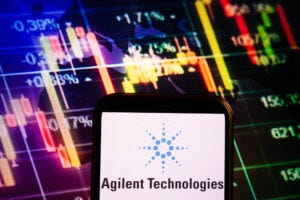Expected revenue growth from emerging biotech has gone from double-digits to a decline says Agilent Technologies, but mid-to-large pharma remains robust.
Instrument and consumable vendor Agilent pulled in $1.72 billion, up 9.5% year-on-year, for its fiscal year 2023 Q2 results. Specifically, revenue for pharma and biopharma grew 11% in Q2 and when Agilent’s Nucleic Acid Solutions Division (NASD) was included it grew 16%.
What made these figure more impressive is the “increasingly challenging market environment,” management explained on the call, specifically affecting the smaller and emerging biotech space.

Image: DepositPhotos/
Piter2121
“The small biotech is pretty much shut down,” CEO Mike McMullen told stakeholders. “We’ve seen real efforts on cash conservation as they’ve been dealing with the financing challenges of less venture capital money out there, banking crises and limited access to the IPO market.”
However, this cohort of customers only represents around 10% of Agilent’s pharma business, CFO Robert McMahon added. “We were projecting that at roughly low double digits, and now we’re expecting that to decline. The rest of the business was high single digits, and now we’re assuming kind of low double digits.”
While demand for consumables and services continued to be strong, management did show concern conservatism is stretching to the medium-sized and large pharma companies when it comes to instrumentation.
“You can make a case that perhaps, there’ll be a year-end budget flush, if customers go to try to spend their year-end money that they’re not spending now,” McMullen said. “We’re not assuming that because all we can really comment on right now is what we’re seeing today. We’re not giving any indications that that situation will change. And I think what remains to be seen is, I think it’s going to be a CEO/CFO decision at our larger pharma companies about how they’ll handle their full year budgets.”
Nucleic Acid Solutions Division
Positivity came from the firm’s nucleic acid division, with management stating it was “super pleased with the performance of NASD” over the quarter.
“We feel good about the performance and are excited about Train B coming online,” McMahon said, referencing its Frederick, Colorado nucleic acid facility.
“That’s why we’re investing another $700 million [plus] in adding Train C and D as well. So we think that we’re in the early stage of therapeutic discovery here in terms of RNA, siRNA-based therapies and there will just be more larger indications as those move through the clinic.”

schedl_b_and_w.jpg?width=100&auto=webp&quality=80&disable=upscale)


schedl_b_and_w.jpg?width=400&auto=webp&quality=80&disable=upscale)


